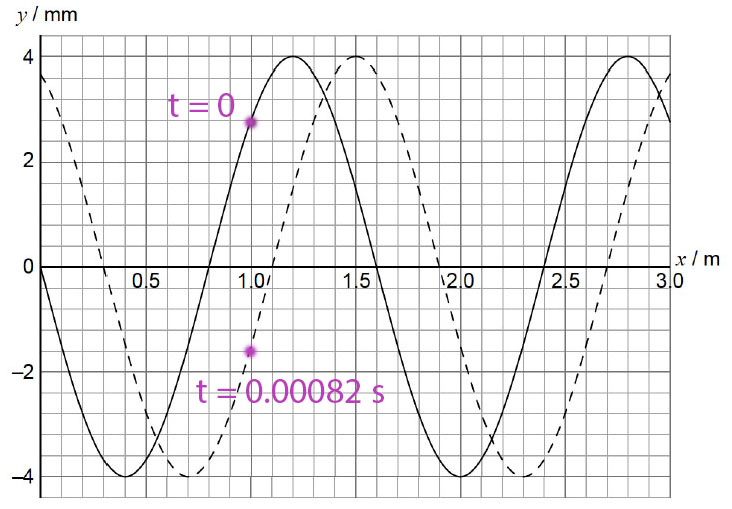IB Physics > Waves > Questions HL 1 - Q1
Q1. A longitudinal wave is travelling in a medium from left to right. The graph shows the variation with distance x of the displacement y of the particles in the medium. The solid line and the dotted line show the displacement at t=0 and t=0.882 ms, respectively.

The period of the wave is greater than 0.882 ms. A displacement to the right of
the equilibrium position is positive.
a. [4 marks]
(i) Calculate the speed of this wave.
(ii) Show that the angular frequency of oscillations of a particle in the medium is
ω=1.3×103rads−1.
b.[4 marks]
One particle in the medium has its equilibrium position at x=1.00 m.
(i) State and explain the direction of motion for this particle at t=0.
(ii) Show that the speed of this particle at t=0.882 ms is 4.9ms−1.
c. [3 marks]
The travelling wave in (b) is directed at the open end of a tube of length
1.20 m. The other end of the tube is closed.
(i) Describe how a standing wave is formed.
(ii) Demonstrate, using a calculation, that a standing wave will be established in
this tube.
ANSWERS and comments:
a.(i)
What is the speed of the wave? The particles oscillate horizontally with variable speed and the wave moves to the right at constant speed. We can look on the graph for two positions of the wave at instants 0 and 0.000882 s. They are separated by 0.3 m (3 squares of the graph)so the speed is:
0.3 / 0.000882 = 340 m/s
This is the speed of sound .
a.(ii)
ω = 2 π / T
T is the period which spans 16 squares on the graph. The time 0.000882 spans 3 squares So T = 0.0047
So, ω = 2 π / T = 6.28 / 0.0047 = 1.3×103rads−1
b.(i)

Observing the graph, we see that at the position x= 1 m the particle moves down the graph as time goes by. As explained before, a downwards movement on the graph means an actual movement towards the left . Because i had a positive displacement at t= 0 and a negative displacement at t = 0.00082 s, we can also say that at t=0 it is moving towards the equilibrium position (with y=0).
b.(ii)
The speed of the oscillating particle is zero at the extremes and maximum at the middle of the movement, so that it is constantly changing. To find the speed at a particular point of the trajectory we a need formula from the booklet , Sub-topic 9.1 – Simple harmonic motion:
$$\begin{aligned} \mathrm{v = \pm \omega \sqrt {(x_o^2-x^2)}} \end{aligned}$$
xo is the maximum displacement . From the graph we sse that it is 4 mm.
x is the position where we want to get the velocity which is 1.5 mm
ω has been calculated on a(ii)
So:
$$\begin{aligned} \mathrm{v = 1.3 * 10^{-3} \sqrt {(0.004^2-0.0015^2)}} \end{aligned}$$
v = 4.9 m / s
Comment: Someone could feel tempted to divide the displacement by the time, like: 4.3 mm / 0.882ms = 4.87 m/s, a number close to the correct answer.
This is wrong because that is a formula for average speed. What is being asked is the speed at a certain point. You would get no marks for that.
